Women Platform Pumps Fashion Roman Style Thick High Heels Red Bottoms

A shoe is an item of footwear intended to protect and comfort the human being human foot. Shoes are also used every bit an item of decoration and fashion. The blueprint of shoes has varied enormously through time and from civilisation to culture, with course originally being tied to function. Though the pes can adapt to varied terrains and climate conditions, it is still vulnerable to environmental hazards such every bit precipitous rocks and temperature extremes, which shoes protect against. Some shoes are worn as prophylactic equipment, such as steel-toe boots which are required footwear at industrial worksites.
Additionally, fashion has oftentimes dictated many design elements, such as whether shoes have very high heels or flat ones. Contemporary footwear varies widely in style, complication and cost. Basic sandals may consist of only a thin sole and simple strap and be sold for a depression cost. Loftier fashion shoes made by famous designers may be made of expensive materials, use complex structure and sell for large sums of coin. Some shoes are designed for specific purposes, such as boots designed specifically for mountaineering or skiing, while others take more than generalized usage such as sneakers which have transformed from a special purpose sport shoe into a full general use shoe.
Traditionally, shoes have been made from leather, wood or sheet, but are increasingly being made from condom, plastics, and other petrochemical-derived materials.[1] Globally, the shoe manufacture is a $200 billion a year industry.[1] 90% of shoes end up in landfills, because the materials are hard to dissever, recycle or otherwise reuse.[1]
History
Antiquity

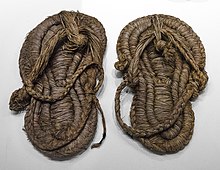

The earliest known shoes are sagebrush bark sandals dating from approximately 7000 or 8000 BC, found in the Fort Stone Cave in the US state of Oregon in 1938.[v] The world'southward oldest leather shoe, made from a unmarried slice of cowhide laced with a leather string forth seams at the front and back, was found in the Areni-1 cavern complex in Armenia in 2008 and is believed to date to 3500 BC.[half-dozen] [7] Ötzi the Iceman's shoes, dating to 3300 BC, featured brown bearskin bases, deerskin side panels, and a bark-cord internet, which pulled tight around the foot.[six] The Jotunheimen shoe was discovered in August 2006: archaeologists guess that this leather shoe was made betwixt 1800 and 1100 BC,[viii] making it the oldest clothing discovered in Scandinavia.
It is thought that shoes may have been used long earlier this, but because the materials used were highly perishable, it is hard to find evidence of the primeval footwear.[9] Past studying the bones of the smaller toes (as opposed to the large toe), it was observed that their thickness decreased approximately 40,000 to 26,000 years ago. This led archaeologists to deduce that wearing shoes resulted in less bone growth, resulting in shorter, thinner toes.[10] These primeval designs were very simple in blueprint, oft mere "foot bags" of leather to protect the feet from rocks, debris, and common cold.
Many early natives in N America wore a similar type of footwear, known as the moccasin. These are tight-fitting, soft-soled shoes typically made out of leather or bison hides. Many moccasins were also decorated with various beads and other adornments. Moccasins were not designed to be waterproof, and in wet conditions and warm summer months, most Native Americans went barefoot.[11]
As civilizations began to develop, thong sandals (the precursors of the modern flip-flop) were worn. This practice dates back to pictures of them in ancient Egyptian murals from 4000 BC. One pair found in Europe was made of papyrus leaves and dated to be approximately i,500 years onetime. They were also worn in Jerusalem during the start century of the Mutual Era.[12] Thong sandals were worn by many civilizations and made from a broad diverseness of materials. Ancient Egyptian sandals were made from papyrus and palm leaves. The Masai of Africa made them out of rawhide. In India they were made from forest. In Red china and Japan, rice harbinger was used. The leaves of the sisal establish were used to make twine for sandals in South America while the natives of Mexico used the Yucca plant.[13] [fourteen]
While thong sandals were commonly worn, many people in ancient times, such every bit the Egyptians, Hindus and Greeks, saw piffling need for footwear, and virtually of the time, preferred being barefoot. The Egyptians and Hindus made some utilise of ornamental footwear, such equally a soleless sandal known equally a "Cleopatra",[ citation needed ] which did non provide any practical protection for the foot. The ancient Greeks largely viewed footwear equally self-indulgent, unaesthetic and unnecessary. Shoes were primarily worn in the theater, every bit a ways of increasing stature, and many preferred to get barefoot.[xv] Athletes in the Ancient Olympic Games participated barefoot—and naked.[16] Even the gods and heroes were primarily depicted barefoot, the hoplite warriors fought battles in blank anxiety and Alexander the Great conquered his vast empire with barefoot armies. The runners of Ancient Greece are too believed to have run barefoot.[17]
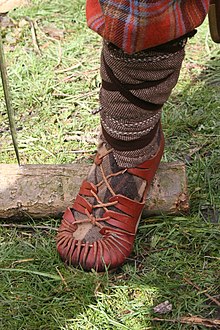
Footwear of Roman soldiers (reconstruction)
The Romans, who somewhen conquered the Greeks and adopted many aspects of their culture, did non prefer the Greek perception of footwear and clothing. Roman clothing was seen as a sign of power, and footwear was seen as a necessity of living in a civilized earth, although the slaves and paupers usually went barefoot.[15] Roman soldiers were issued with chiral (left and right shoe different) footwear.[18] Shoes for soldiers had riveted insoles to extend the life of the leather, increment comfortability, and provide amend traction. The design of these shoes also designated the rank of the officers. The more intricate the insignia and the college up the boot went on the leg, the higher the rank of the soldier.[19] There are references to shoes beingness worn in the Bible.[twenty]
Starting effectually 4 BC, the Greeks began wearing symbolic footwear. These were heavily busy to clearly indicate the condition of the wearer. Courtesans wore leather shoes colored with white, green, lemon or yellowish dyes, and young woman matrimonial or newly married wore pure white shoes. Because of the cost to lighten leather, shoes of a paler shade were a symbol of wealth in the upper class. Often, the soles would be carved with a bulletin and so it would imprint on the ground. Cobblers became a notable profession effectually this time, with Greek shoemakers becoming famed in the Roman empire.[21]
Middle Ages and Early Modern period
A common casual shoe in the Pyrenees during the Middle Ages was the espadrille. This is a sandal with braided jute soles and a fabric upper portion, and frequently includes textile laces that tie around the ankle. The term is French and comes from the esparto grass. The shoe originated in the Catalonian region of Kingdom of spain every bit early as the 13th century, and was commonly worn by peasants in the farming communities in the area.[14]
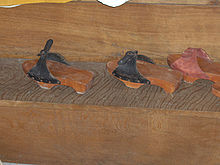
In medieval times shoes could exist up to two feet long, with their toes sometimes filled with hair, wool, moss, or grass.[22] Many medieval shoes were made using the turnshoe method of structure, in which the upper was turned flesh side out, and was lasted onto the sole and joined to the edge by a seam.[23] The shoe was then turned within-out so that the grain was outside. Some shoes were developed with toggled flaps or drawstrings to tighten the leather effectually the human foot for a amend fit. Surviving medieval turnshoes often fit the foot closely, with the correct and left shoe being mirror images.[24] Around 1500, the turnshoe method was largely replaced by the welted rand method (where the uppers are sewn to a much stiffer sole and the shoe cannot be turned inside-out).[25] The plow shoe method is still used for some dance and specialty shoes.
Past the 15th century, pattens became popular past both men and women in Europe. These are commonly seen every bit the predecessor of the modern high-heeled shoe,[26] while the poor and lower classes in Europe, every bit well as slaves in the New World, were barefoot.[15] In the 15th century, the Crakow was fashionable in Europe. This way of shoe is named considering it is idea to have originated in Kraków, the upper-case letter of Poland. The style is characterized by the indicate of the shoe, known as the "polaine", which ofttimes was supported past a whalebone tied to the human knee to prevent the betoken getting in the fashion while walking.[27] Besides during the 15th century, chopines were created in Turkey, and were usually vii–8 inches (17.vii–xx.3 cm) high. These shoes became popular in Venice and throughout Europe, as a status symbol revealing wealth and social standing. During the 16th century, royalty, such equally Catherine de Medici or Mary I of England, started wearing high-heeled shoes to make them look taller or larger than life. By 1580, fifty-fifty men wore them, and a person with authority or wealth was often referred to as, "well-heeled".[26] In 17th century French republic, heels were exclusively worn past aristocrats. Louis Xiv of France outlawed anybody from wearing red high heels except for himself and his imperial court.[28]
Somewhen the mod shoe, with a sewn-on sole, was devised. Since the 17th century, well-nigh leather shoes take used a sewn-on sole. This remains the standard for finer-quality dress shoes today. Until around 1800, welted rand shoes were normally made without differentiation for the left or right foot. Such shoes are at present referred to as "straights".[29] Just gradually did the modern foot-specific shoe become standard.
Industrial era

A shoemaker in the Georgian era, from The Book of English Trades, 1821.
Shoemaking became more than commercialized in the mid-18th century, as it expanded as a cottage industry. Large warehouses began to stock footwear, made by many small manufacturers from the area.
Until the 19th century, shoemaking was a traditional handicraft, but by the century's finish, the procedure had been almost completely mechanized, with product occurring in large factories. Despite the obvious economic gains of mass production, the manufactory organisation produced shoes without the individual differentiation that the traditional shoemaker was able to provide.
The showtime steps towards mechanisation were taken during the Napoleonic Wars past the engineer, Marc Brunel. He developed machinery for the mass product of boots for the soldiers of the British Ground forces. In 1812, he devised a scheme for making nailed-boot-making machinery that automatically attached soles to uppers by means of metallic pins or nails.[30] With the support of the Duke of York, the shoes were manufactured, and, due to their strength, cheapness, and durability, were introduced for the utilise of the army. In the same twelvemonth, the use of screws and staples was patented by Richard Woodman. Brunel's system was described past Sir Richard Phillips as a company to his factory in Battersea as follows:
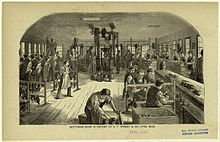
By the belatedly 19th century, the shoemaking manufacture had migrated to the factory and was increasingly mechanized. Pictured, the bottoming room of the B. F. Spinney & Co. mill in Lynn, Massachusetts, 1872.
In another edifice I was shown his factory of shoes, which, similar the other, is total of ingenuity, and, in regard to subdivision of labour, brings this textile on a level with the ofttimes-admired mill of pins. Every step in it is affected by the about elegant and precise mechanism; while, equally each operation is performed past i hand, so each shoe passes through xx-five easily, who complete from the hide, every bit supplied by the currier, a hundred pairs of stiff and well-finished shoes per day. All the details are performed by the ingenious awarding of the mechanic powers; and all the parts are characterised past precision, uniformity, and accuracy. As each homo performs but ane step in the procedure, which implies no noesis of what is done by those who go before or follow him, so the persons employed are not shoemakers, merely wounded soldiers, who are able to learn their respective duties in a few hours. The contract at which these shoes are delivered to Government is 6s. 6d. per pair, existence at to the lowest degree 2s. less than what was paid previously for an diff and cobbled commodity.[31]
Nevertheless, when the state of war ended in 1815, manual labour became much cheaper, and the demand for armed services equipment subsided. As a consequence, Brunel's system was no longer profitable and it soon ceased business concern.[30]
Similar exigencies at the time of the Crimean State of war stimulated a renewed involvement in methods of mechanization and mass-product, which proved longer lasting.[30] A shoemaker in Leicester, Tomas Crick, patented the design for a riveting auto in 1853. His machine used an iron plate to push iron rivets into the sole. The process greatly increased the speed and efficiency of production. He also introduced the use of steam-powered rolling-machines for hardening leather and cutting-machines, in the mid-1850s.[32]

Ad in an 1896 result of McClure's for "The Regal".

The sewing auto was introduced in 1846, and provided an culling method for the mechanization of shoemaking. By the tardily 1850s, the manufacture was get-go to shift towards the modern manufacturing plant, mainly in the Us and areas of England. A shoe-stitching machine was invented by the American Lyman Blake in 1856 and perfected by 1864. Entering into a partnership with McKay, his device became known as the McKay stitching machine and was quickly adopted by manufacturers throughout New England.[33] Equally bottlenecks opened up in the production line due to these innovations, more and more than of the manufacturing stages, such as pegging and finishing, became automated. By the 1890s, the process of mechanisation was largely consummate.
On January 24, 1899, Humphrey O'Sullivan of Lowell, Massachusetts, was awarded a patent for a condom heel for boots and shoes.[34]
A process for manufacturing stitchless, that is, glued, shoes—AGO—was developed in 1910. Since the mid-20th century, advances in rubber, plastics, synthetic cloth, and industrial adhesives have allowed manufacturers to create shoes that stray considerably from traditional crafting techniques. Leather, which had been the primary textile in earlier styles, has remained standard in expensive clothes shoes, merely athletic shoes often have little or no real leather. Soles, which were once laboriously manus-stitched on, are now more than oft machine stitched or simply glued on. Many of these newer materials, such as safety and plastics, accept fabricated shoes less biodegradable. It is estimated that most mass-produced shoes require 1000 years to degrade in a landfill.[35] In the late 2000s, some shoemakers picked upwards on the event and began to produce shoes made entirely from degradable materials, such as the Nike Considered.[36] [37]
In 2007, the global shoe industry had an overall market of $107.iv billion, in terms of revenue, and is expected to grow to $122.nine billion by the stop of 2012. Shoe manufacturers in the People'south Commonwealth of Communist china account for 63% of production, xl.five% of global exports and 55% of industry revenue. Even so, many manufacturers in Europe dominate the college-priced, higher value-added stop of the market.[38]
Culture and folklore



Children'south shoes at schoolhouse in Ladakh
As an integral part of human culture and civilization, shoes have found their style into our culture, folklore, and art. A pop 18th-century nursery rhyme is There was an Old Woman Who Lived in a Shoe. This story tells about an old woman living in a shoe with a lot of children. In 1948, Mahlon Haines, a shoe salesman in Hallam, Pennsylvania, built an actual house shaped like a piece of work kicking as a form of advertisement. The Haines Shoe House was rented to newlyweds and the elderly until his decease in 1962. Since then, it has served as an ice cream parlor, a bed and breakfast, and a museum. It still stands today and is a pop roadside allure.[39]
Shoes also play an important role in the fairy tales Cinderella and The Red Shoes. In the movie adaption of the children'southward book The Wonderful Wizard of Oz, a pair of cherry ruby slippers play a fundamental role in the plot. The 1985 comedy The Man with I Red Shoe features an eccentric human wearing ane normal business shoe and one red shoe that becomes fundamental to the plot.
Athletic sneaker drove has also existed as a part of urban subculture in the United States for several decades.[twoscore] Recent decades have seen this trend spread to European nations such as the Czech republic.[41] A Sneakerhead is a person who owns multiple pairs of shoes as a grade of collection and fashion. A correspondent to the growth of sneaker collecting is the continued worldwide popularity of the Air Jordan line of sneakers designed by Nike for Basketball star Michael Jordan.
In the Bible's Old Testament, the shoe is used to symbolize something that is worthless or of piffling value. In the New Attestation, the act of removing one's shoes symbolizes servitude. Ancient Semitic-speaking peoples regarded the act of removing their shoes as a marking of reverence when approaching a sacred person or place.[42] In the Volume of Exodus, Moses was instructed to remove his shoes earlier approaching the burning bush:
Put off thy shoes from off thy anxiety, for the place whereon m standest [is] holy footing (Exodus iii:5).

The removal of the shoe likewise symbolizes the human activity of giving up a legal right. In Hebrew custom, the widow removed the shoe of her late husband's blood brother to symbolize that he had abandoned his duty. In Arab custom, the removal of one's shoe likewise symbolized the dissolution of marriage.[42]
In Arab civilization, showing the sole of i'south shoe is considered an insult, and to throw a shoe and hit someone with it is considered an fifty-fifty greater insult. Shoes are considered to be dirty as they often touch the ground, and are associated with the lowest part of the body—the pes. As such, shoes are forbidden in mosques, and it is besides considered unmannerly to cross the legs and brandish the soles of 1's shoes during chat. This insult was demonstrated in Iraq, first when Saddam Hussein's statue was toppled in 2003, Iraqis gathered around it and struck the statue with their shoes.[43] In 2008, Usa President George W. Bush had a shoe thrown at him by a announcer as a statement against the war in Iraq.[44] More generally, shoe-throwing or shoeing, showing the sole of one'southward shoe or using shoes to insult are forms of protestation in many parts of the world. Incidents where shoes were thrown at political figures have taken identify in Australia, India, Republic of ireland, Taiwan, Hong Kong, Pakistan, the United kingdom of great britain and northern ireland, the United states, and most notably the Arab world.[45] [46]
Empty shoes may also symbolize decease. In Greek civilization, empty shoes are the equivalent of the American funeral wreath. For example, empty shoes placed outside of a Greek abode would tell others that the family's son has died in boxing.[47] At an observation memorializing the 10th anniversary of the September eleven attacks, 3,000 pairs of empty shoes were used to recognize those killed.[48] The Shoes on the Danube Banking concern is a memorial in Budapest, Hungary. Conceived by picture show director Tin can Togay, he created information technology on the e bank of the Danube River with sculptor Gyula Pauer to honor the Jews who were killed past fascist Arrow Cross militiamen in Budapest during World War II. They were ordered to take off their shoes and were shot at the edge of the water so that their bodies fell into the river and were carried away. The memorial represents their shoes left behind on the bank.
Structure
The bones anatomy of a shoe is recognizable, regardless of the specific mode of footwear.
All shoes have a sole , which is the lesser of a shoe, in contact with the ground. Soles tin be made from a multifariousness of materials, although most modern shoes have soles made from natural safety, polyurethane, or polyvinyl chloride (PVC) compounds.[49] Soles tin be uncomplicated—a single material in a single layer—or they can be complex, with multiple structures or layers and materials. When various layers are used, soles may consist of an insole, midsole, and an outsole.[l]
The insole is the interior bottom of a shoe, which sits straight beneath the human foot under the footbed (also known as sock liner). The purpose of the insole is to attach to the lasting margin of the upper, which is wrapped around the terminal during the endmost of the shoe during the lasting performance. Insoles are usually fabricated of cellulosic paper board or synthetic non woven insole board. Many shoes have removable and replaceable footbeds. Actress cushioning is often added for comfort (to control the shape, moisture, or smell of the shoe) or health reasons (to help deal with differences in the natural shape of the foot or positioning of the foot during standing or walking).[l]
The outsole is the layer in straight contact with the ground. Wearing apparel shoes often have leather or resin prophylactic outsoles; casual or work-oriented shoes have outsoles fabricated of natural rubber or a constructed cloth like polyurethane. The outsole may incorporate a single piece or mayhap an assembly of divide pieces, frequently of different materials. On some shoes, the heel of the sole has a safety plate for durability and traction, while the front is leather for style. Specialized shoes volition often take modifications on this design: athletic or and then-chosen cleated shoes like soccer, rugby, baseball and golf shoes accept spikes embedded in the outsole to improve traction.[fifty]
The midsole is the layer in betwixt the outsole and the insole, typically at that place for shock absorption. Some types of shoes, like running shoes, have additional material for shock absorption, unremarkably below the heel of the pes, where one puts the most pressure down. Some shoes may non have a midsole at all.[50]
The heel is the bottom rear part of a shoe. Its office is to support the heel of the foot. They are often made of the same material as the sole of the shoe. This part can be high for fashion or to make the person look taller, or flat for more applied and comfy use.[50] On some shoes the inner forward point of the heel is chiselled off, a feature known every bit a "admirer's corner". This piece of design is intended to convalesce the problem of the points catching the bottom of trousers and was first observed in the 1930s.[51] A heel is the projection at the dorsum of a shoe which rests below the heel bone. The shoe heel is used to improve the residue of the shoe, increase the peak of the wearer, alter posture or other decorative purposes. Sometimes raised, the high heel is common to a course of shoe often worn by women, but sometimes by men too. See besides stiletto heel.
The upper helps hold the shoe onto the foot. In the simplest cases, such as sandals or flip-flops, this may exist nothing more than a few straps for holding the sole in place. Closed footwear, such as boots, trainers and nigh men'south shoes, will have a more complex upper. This office is often decorated or is made in a certain mode to await attractive. The upper is connected to the sole by a strip of leather, prophylactic, or plastic that is stitched between it and the sole, known as a welt.[l]
Virtually uppers have a mechanism, such equally laces, straps with buckles, zippers, elastic, velcro straps, buttons, or snaps, for tightening the upper on the foot. Uppers with laces commonly have a tongue that helps seal the laced opening and protect the foot from abrasion by the laces. Uppers with laces likewise take eyelets or hooks to make it easier to tighten and loosen the laces and to forbid the lace from tearing through the upper material. An aglet is the protective wrapping on the stop of the lace.
The vamp is the front part of the shoe, starting behind the toe, extending around the eyelets and natural language and towards back part of the shoe.
The medial is the part of the shoe closest to a person's eye of symmetry, and the lateral is on the opposite side, away from their eye of symmetry. This can exist in reference to either the outsole or the vamp. Most shoes have shoelaces on the upper, connecting the medial and lateral parts afterward ane puts their shoes on and aiding in keeping their shoes on their feet. In 1968, Puma SE introduced the offset pair of sneakers with Velcro straps in lieu of shoelaces, and these became popular by the 1980s, especially among children and the elderly.[52] [53]
The toe box is the part that covers and protects the toes. People with toe deformities, or individuals who experience toe swelling (such as long-distance runners) usually require a larger toe box.[54]
-

Diagram of a typical dress shoe. Note that the area labeled every bit the "Lace guard" is sometimes considered role of the quarter and sometimes part of the vamp.
-
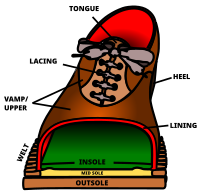
Cutaway view of a typical shoe.
Types
In that location are a wide multifariousness of dissimilar types of shoes. Near types of shoes are designed for specific activities. For case, boots are typically designed for work or heavy outdoor apply. Athletic shoes are designed for particular sports such as running, walking, or other sports. Some shoes are designed to be worn at more formal occasions, and others are designed for coincidental clothing. There are also a wide variety of shoes designed for different types of dancing. Orthopedic shoes are special types of footwear designed for individuals with particular foot problems or special needs. Other animals, such every bit dogs and horses, may also habiliment special shoes to protect their feet every bit well.
Depending on the activity for which they are designed, some types of footwear may fit into multiple categories. For example, Cowboy boots are considered boots, but may as well exist worn in more formal occasions and used as wearing apparel shoes. Hiking boots incorporate many of the protective features of boots, just also provide the extra flexibility and comfort of many athletic shoes. Flip-flops are considered casual footwear, merely have besides been worn in formal occasions, such equally visits to the White House.[55] [56]
Athletic
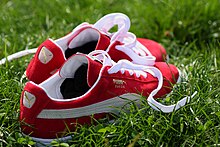
A pair of athletic running shoes
Athletic shoes are specifically designed to be worn for participating in diverse sports. Since friction between the foot and the ground is an important strength in most sports, modern athletic shoes are designed to maximize this force, and materials, such as condom, are used. Although, for some activities such every bit dancing or bowling, sliding is desirable, and then shoes designed for these activities often have lower coefficients of friction.[57] The earliest athletic shoes date back to the mid 19th century were track spikes—leather shoes with metal cleats on the soles to provide increased friction during running. They were developed by J.W. Foster & Sons, which later on become known equally Reebok. By the end of the 19th century, Spalding also manufactured these shoes as well. Adidas started selling shoes with track spikes in them for running and soccer in 1925. Spikes were eventually added to shoes for baseball and American football game in the 20th century.[14] Golfers also use shoes with small metal spikes on their soles to prevent slipping during their swing.[58]
The earliest safe-soled able-bodied shoes date dorsum to 1876 in the Great britain, when the New Liverpool Condom Visitor fabricated plimsolls, or sandshoes, designed for the sport of croquet. Like rubber-soled shoes were made in 1892 in the United states by Humphrey O'Sullivan, based on Charles Goodyear's technology. The U.s.a. Rubber Company was founded the same year and produced rubber-soled and heeled shoes nether a multifariousness of brand names, which were later consolidated in 1916 under the name, Keds. These shoes became known as, "sneakers", because the rubber sole allowed the wearer to sneak upwardly on some other person. In 1964, the founding of Nike past Phil Knight and Bill Bowerman of the University of Oregon introduced many new improvements common in mod running shoes, such equally condom waffle soles, breathable nylon uppers, and cushioning in the mid-sole and heel. During the 1970s, the expertise of podiatrists besides became important in able-bodied shoe design, to implement new design features based on how feet reacted to specific actions, such as running, jumping, or side-to-side movement. Athletic shoes for women were likewise designed for their specific physiological differences.[14]
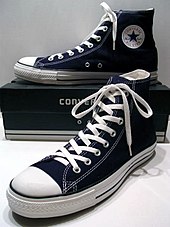
A pair of Converse All-Stars
Shoes specific to the sport of basketball were developed by Chuck Taylor, and are popularly known as Chuck Taylor All-Stars. These shoes, showtime sold in 1917, are double-layer canvas shoes with rubber soles and toe caps, and a high heel (known equally a "high top") for added support. In 1969, Taylor was inducted into the Naismith Memorial Basketball game Hall of Fame in recognition of this evolution, and in the 1970s, other shoe manufacturers, such every bit Nike, Adidas, Reebok, and others began imitating this style of able-bodied shoe.[59] In April 1985, Nike introduced its own brand of basketball shoe which would get popular in its own right, the Air Hashemite kingdom of jordan, named later the then-rookie Chicago Bulls basketball thespian, Michael Jordan. The Air Jordan line of shoes sold $100 million in their outset year.[60]
As barefoot running became pop by the late 20th and early 21st century, many modern shoe manufacturers take recently designed footwear that mimic this experience, maintaining optimum flexibility and natural walking while also providing some caste of protection. Termed as Minimalist shoes, their purpose is to allow one'south anxiety and legs to feel more subtly the impacts and forces involved in running, assuasive finer adjustments in running style.[61] Some of these shoes include the Vibram FiveFingers,[62] Nike Costless,[63] and Saucony'south Kinvara and Hattori.[64] [65] Mexican huaraches are also very unproblematic running shoes, like to the shoes worn past the Tarahumara people of northern United mexican states, who are known for their distance running abilities.[66] Wrestling shoes are too very light and flexible shoes that are designed to mimic bare feet while providing additional traction and protection.
Many athletic shoes are designed with specific features for specific activities. One of these includes roller skates, which accept metallic or plastic wheels on the bottom specific for the sport of roller skating. Similarly, ice skates have a metallic bract attached to the bottom for locomotion across water ice. Skate shoes take as well been designed to provide a comfortable, flexible and durable shoe for the sport of skateboarding.[67] Climbing shoes are rubber-soled, tight-plumbing equipment shoes designed to fit in the small cracks and crevices for rock climbing. Cycling shoes are similarly designed with rubber soles and a tight fit, only also are equipped with a metal or plastic cleat to interface with clipless pedals, as well as a stiff sole to maximize ability transfer and support the pes.[68] Some shoes are made specifically to improve a person'due south ability to weight railroad train.[69] Sneakers that are a mix between an activity-centered and a more standard design have as well been produced: examples include roller shoes, which feature wheels that can be used to roll on hard ground, and Soap shoes, which characteristic a hard plastic sole that tin can be used for grinding.
Boot
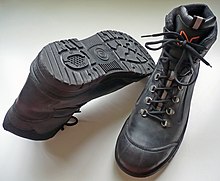
A boot is a special type of shoe which covers the foot and the ankle and extends up the leg, sometimes equally far as the knee or even the hip. Most boots have a heel that is clearly distinguishable from the rest of the sole, fifty-fifty if the two are fabricated of one piece. They are typically made of leather or rubber, although they may be made from a variety of different materials. Boots are worn both for their functionality—protecting the human foot and leg from water, snow, mud or hazards or providing additional talocrural joint support for strenuous activities—every bit well as for reasons of way and fashion.
Cowboy boots are a specific style of riding boot which combines function with fashion. They became popular amongst cowboys in the western United states during the 19th century. Traditional cowboy boots have a Cuban heel, rounded to pointed toe, high shaft, and, traditionally, no lacing.[70] They are commonly made from cowhide leather but may be made from more exotic skins such as ostrich, anaconda, or elephant skins.[71]
Hiking boots are designed to provide extra ankle and arch support, as well as extra padding for condolement during hiking. They are synthetic to provide comfort for miles of walking over rough terrains, and protect the hiker's feet against h2o, mud, rocks, and other wilderness obstacles. These boots support the ankle to avoid twisting but do non restrict the ankle's motion as well much. They are fairly stiff to support the pes. A properly fitted boot and/or friction-reducing patches applied to troublesome areas ensures protection confronting blisters and other discomforts associated with long hikes on rugged terrain.[72]
During wet or snowy weather condition, snowfall boots are worn to keep the foot warm and dry. They are typically made of prophylactic or other h2o-resistant cloth, have multiple layers of insulation, and a high heel to go along snow out.[73] Boots may also be attached to snowshoes to increase the distribution of weight over a larger surface area for walking in snow. Ski boots are a specialized snow kicking which are used in alpine or cross-state skiing and designed to provide a way to attach the skier to his/her skis using ski bindings. The ski/boot/binding combination is used to effectively transmit control inputs from the skier's legs to the snow. Ice skates are another specialized boot with a metallic bract attached to the bottom which is used to propel the wearer across a sheet of ice.[74] Inline skates are similar to water ice skates just with a set of three to four wheels in lieu of the blade, which are designed to mimic ice skating on solid surfaces such equally wood or physical.[75]
Boots are designed to withstand heavy wear to protect the wearer and provide good traction. They are generally fabricated from sturdy leather uppers and not-leather outsoles. They may be used for uniforms of the constabulary or armed forces, besides equally for protection in industrial settings such every bit mining and construction. Protective features may include steel-tipped toes and soles or ankle guards.[76]
Dress and casual
Clothes shoes are characterized by smooth and supple leather uppers, leather soles, and narrow sleek effigy. Coincidental shoes are characterized by sturdy leather uppers, non-leather outsoles, and wide contour.
Some designs of wearing apparel shoes can be worn by either gender. The majority of apparel shoes have an upper covering, commonly made of leather, enclosing most of the lower human foot, merely non covering the ankles. This upper part of the shoe is often made without apertures or openings, but may also be made with openings or even itself consist of a serial of straps, e.chiliad. an open toe featured in women's shoes. Shoes with uppers made loftier to cover the ankles are also bachelor; a shoe with the upper rising above the ankle is normally considered a boot only certain styles may be referred to equally loftier-topped shoes or high-tops. Usually, a high-topped shoe is secured by laces or zippers, although some styles accept elastic inserts to ease slipping the shoe on.
Men's

This male dress shoe, known every bit a derby shoe, is distinguished past its open up lacing.
Men'southward shoes can be categorized by how they are closed:
- Oxfords (besides referred equally "Balmorals"): the vamp has a V-shaped slit to which the laces are fastened; also known as "closed lacing". The give-and-take "Oxford" is sometimes used by American clothing companies to market shoes that are not Balmorals, such as bluchers.
- Derby shoe: the laces are tied to two pieces of leather independently fastened to the vamp; also known as "open lacing" and is a stride downwardly in dressiness. If the laces are not independently attached to the vamp, the shoe is known as a blucher shoe. This name is, in American English, ofttimes used most derbys.
- Monk-straps: a buckle and strap instead of lacing
- Slip-ons: At that place are no lacings or fastenings. The popular loafers are part of this category, also as less popular styles, such as elastic-sided shoes.
Men'southward shoes can also exist decorated in various ways:
- Plain-toes: take a sleek appearance and no extra decorations on the vamp.
- Cap-toes: has an actress layer of leather that "caps" the toe.
- Brogues (American: wing-tips): The toe of the shoe is covered with a perforated panel, the wing-tip, which extends downwardly either side of the shoe. Brogues can exist found in both balmoral and blucher styles, but are considered slightly less formal.
Formal loftier-end men's shoes are manufactured by several companies around the globe, amongst others in Great britain, French republic, Hungary, Romania, Croatia, Italia, and to a lesser extent in the United States. Notable British brands include: Church's English Shoes (est. 1873), John Lobb Bootmaker (est. 1849), Edward Light-green Shoes (est. 1890), and Crockett & Jones (est. 1879). Both John Lobb and Edward Green offer bespoke products. In betwixt the world wars, men's footwear received significant innovation and design, led by cobblers and cordwainers in London's West End.[77] A well-known French maker is J.Grand. Weston. Armani of Italy was a major influence on men's shoe blueprint in the 1960s–1980s until they returned to the larger proportions of its forebears, the welt-constructed Anglo-American wearing apparel shoe originally created in Edwardian England. Another well-known Italian company is Salvatore Ferragamo Italia Due south.p.A. Higher end companies in the United States are Allen Edmonds and Alden Shoe Company. Alden, located in New England, specializes in genuine shell cordovan leather from the only remaining horse tannery in the U.s.a., in Chicago[78] and is completely manufactured domestically, whereas Allen Edmonds, of Wisconsin, is a larger visitor that outsources some of its production.[79]
Women's

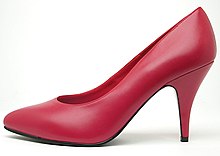
There is a large variety of shoes available for women, in addition to most of the men's styles being more than accepted as unisex. Some broad categories are:
- High-heeled footwear is footwear that raises the heels, typically 2 inches (5 cm) or more above the toes, commonly worn by women for formal occasions or social outings. Variants include kitten heels (typically 1+ 1⁄two –2 inches high) and stiletto heels (with a very narrow heel post) and wedge heels (with a wedge-shaped sole rather than a heel post).
- Mules are shoes or slippers with no plumbing fixtures around the heel (i.e. they are backless)
- Slingbacks are shoes which are secured by a strap backside the heel, rather than over the top of the foot.
- Ballet flats, known in the UK as ballerinas, ballet pumps or skimmers, are shoes with a very depression heel and a relatively short vamp, exposing much of the instep. They are popular for warm-weather vesture, and may be seen as more comfortable than shoes with a higher heel.
- Court shoes, known in the U.s.a. equally pumps, are typically high-heeled, slip-on dress shoes.
Unisex
- Clog
- Platform shoe: shoe with very thick soles and heels
- Sandals: open shoes consisting of a sole and diverse straps, leaving much of the foot exposed to air. They are thus popular for warm-weather condition wear, because they allow the foot be libation than a airtight-toed shoe would.
- Saddle shoe: leather shoe with a contrasting saddle-shaped band over the instep, typically white uppers with blackness "saddle".
- Sideslip-on shoe: a dress or casual shoe without shoelaces or fasteners; oftentimes with tassels, buckles, or coin-holders (penny loafers).
- Boat shoes, too known every bit "deck shoes": similar to a loafer, just more casual. Laces are usually simple leather with no frills. Typically made of leather and featuring a soft white sole to avoid marring or scratching a gunkhole deck. The first boat shoe was invented in 1935 by Paul A. Sperry.
- Slippers: For indoor use, commonly worn with pajamas.
Dance
A wide multifariousness of footwear is used by dancers. The choice of dance shoe type depends on the style of trip the light fantastic that is to exist performed and, in many cases, the characteristics of the surface that will exist danced on.
- Pointe shoes are designed for ballet dancing. These take a toe box that is stiffened with glue and a hardened sole so the dancer can stand on the tips of their toes. They are secured by elastic straps and ribbons that are tied to the dancer's ankles.
- Ballet shoes are soft, pliable shoes made of canvas or leather, with either continuous or two-part sole (as well chosen dissever-sole), used for ballet dancing. The sole is typically made of leather, with thicker textile nether the ball and heel of the pes, and thinner and thus more flexible material nether the arch and then that the foot tin can be easily pointed. They are typically secured past elastics beyond the top of the human foot.
- Ghillies are soft shoes that are used in Irish dance, Scottish country trip the light fantastic, and highland dance.
- Jazz shoes typically have a two-office rubberized sole (also chosen split-sole) to provide both flexibility and traction, and a short heel. They are secured to the human foot by laces or elastic inserts.
- Tango and Flamenco shoes are used for tango or flamenco dancing.
- Ballroom shoes fall into two categories: Ballroom and Latin American. Both are characterised by suede soles. Men's ballroom shoes are typically lace-ups with one-inch heels and patent leather uppers. Ladies' ballroom shoes are typically court shoes with two-inch heels, made of fabric that tin can be colored to match the dancer's dress. In dissimilarity to the low Ballroom heel, which evenly distributes weight across the foot, Latin American shoes have higher heels designed to shift weight onto the toes. Latin shoes are also more flexible than ballroom shoes. Men's Latin shoes typically have 1.5- to 2-inch high, shaped heels, while Ladies' Latin shoes have 2.5-inch to 3-inch heels. Ladies shoes are typically open-toed and strapped.
- Dance sneakers are lightweight sneakers with reinforced rubber toes that allows dancers to briefly stand on their toes. These are known by diverse trademarked names, such as dansneakers.
- Pes thongs are slip-on, fractional foot covers that comprehend the brawl of the dancer'south human foot then as to reduce friction while executing turns, thus making it easier to perform turns and too protecting the pes from peel abrasions. From a distance, flesh colored foot thongs give a dancer the appearance of having bare anxiety. They are known by various names depending on the manufacturer, including trip the light fantastic paws, foot undies, and foot paws.
- Tap shoes have metal plates mounted to the bottoms of the toe and heel. The metallic plates, which are known as taps, make a loud sound when struck against a difficult operation surface. Tap shoes, which are used in tap dancing, may be fabricated from any mode of shoe to which taps can be fastened.
- Grapheme shoes are leather shoes with one- to three-inch heels, normally with ane or more straps across the instep to secure information technology to the pes. They may exist soft-soled (suede) or hard-soled. They may be converted to tap shoes past attaching taps.
-
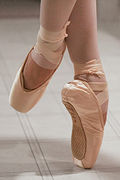
-

-
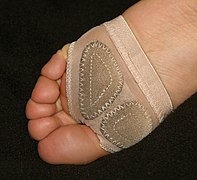
A foot thong, viewed from the bottom
-
-

Ladies' ballroom shoes
-
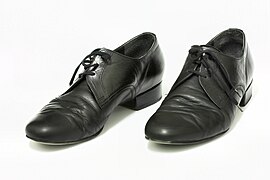
Men's ballroom shoes
-
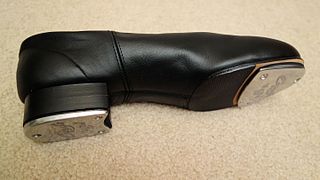
Orthopedic
Orthopedic shoes are specially-designed footwear to relieve discomfort associated with many foot and ankle disorders, such every bit blisters, bunions, calluses and corns, hammer toes, plantar fasciitis, or heel spurs. Certain types of therapeutic footwear are prescribed for children[80] [81] with mobility problems.[82] They may also be worn past individuals with diabetes or people with unequal leg length. These shoes typically have a low heel, tend to be broad with a particularly wide toe box, and take a firm heel to provide extra support. Some may too have a removable insole, or orthotic, to provide extra arch support.[14]
Measures and sizes
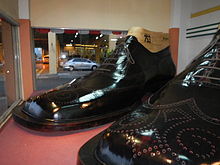
Earth's largest pair of shoes, Riverbank Heart, Philippines—5.29 metres (17.4 ft) long and two.37 metres (7 ft 9 in) wide, equivalent to a French shoe size of 75.
The measure out of a pes for a shoe is from the heel to the longest toe. Shoe size is an alphanumerical indication of the fitting size of a shoe for a person. Oftentimes information technology just consists of a number indicating the length because many shoemakers only provide a standard width for economic reasons. At that place are several different shoe-size systems that are used worldwide. These systems differ in what they measure, what unit they use, and where the size 0 (or one) is positioned. But a few systems also take the width of the anxiety into account. Some regions employ different shoe-size systems for different types of shoes (east.g., men'due south, women's, children's, sport, or rubber shoes).

Units for shoe sizes vary widely around the earth. European sizes are measured in Paris Points, which are worth two-thirds of a centimeter. The UK and American units effect in whole-number sizes spaced at 1 barleycorn ( i⁄3 inch), with Great britain adult sizes starting at size 1 = viii+ 2⁄3 in (22.0 cm). In the U.s., this is size 2. Men's and women's shoe sizes frequently accept dissimilar scales.[ commendation needed ] Shoe size is often measured using a Brannock Device, which tin can make up one's mind both the width and length size values of the pes.[83] A metric standard for shoe sizing, the Mondopoint system, was introduced in the 1970s by International Standard ISO 2816:1973 "Primal characteristics of a organization of shoe sizing to be known as Mondopoint" and ISO 3355:1975 "Shoe sizes – System of length grading (for utilise in the Mondopoint system)".[84] the current version of the standard is ISO 9407:2019, "Shoe sizes—Mondopoint system of sizing and mark".[85] The Mondopoint system includes measurements of both length and width of the pes.
Accessories
- Foam tap: a minor foam pad placed under the ball of the foot to push the foot upwardly and back if the shoe is also loose.
- Heel grip: used to foreclose the shoe from slipping on the heel if the fit is non perfect
- Overshoes or galoshes: a rubber covering placed over shoes for rain and snow protection.
- Shoe bag: a purse that protects shoes confronting damage when they are not being worn.
- Shoe brush and polishing fabric: used to apply smoothen to shoes.
- Shoe insert, insole or inner sole: orthopedic or regular insert of various materials for cushioning, improved fit, reduced abrasion or to keep shoe fresh and increase its durability. These include padding and inner linings. Inserts may besides be used to correct human foot bug.
- Shoe polish: a waxy material spread on shoes to improve advent and glossiness, and provide protection.
- Shoe stretcher: a tool for making a shoe longer or wider or for reducing discomfort in areas of a shoe.
- Shoe tree: placed inside the shoe when user is non wearing it, to aid maintain the shoe's shape.
- Shoehorn: tin can be used to insert a foot into a shoe by keeping the shoe open and providing a smooth surface for the foot to slide upon.
- Shoelaces: a organization used to secure shoes.
- Snow shoe: a wooden or leather piece that increases the surface area of footing covered by the shoe.
Removal of shoes
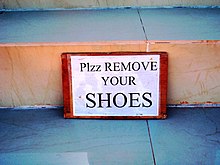
PLZZ REMOVE YOUR SHOES. Sign at entrance to stupa. Nubra, Bharat
In many places in the globe shoes are removed when moving from exteriors to interiors, particularly in homes and religious buildings. In many Asian countries outdoor shoes are exchanged for indoor shoes or slippers. Some fettle centres require that shoes be exchanged for indoor shoes to prevent dirt and crud from being transferred to the equipment.
See also
- Foot bounden
- List of shoe companies
- List of shoe styles
- Locomotor furnishings of shoes
- Runner'southward toe, injury from malfitting shoes
- Shoe dryer
- Shoe rack
- Shoe tossing
- Trousers
References
- ^ a b c Hoskins, Tansy E. (2020-03-21). "'Some soles terminal 1,000 years in landfill': the truth about the sneaker mountain". The Guardian . Retrieved 2021-02-19 .
- ^ "The Scottish Ten". The Engine Shed. Centre for Digital Documentation and Visualisation LLP. Retrieved 14 October 2017.
- ^ "Lady'southward Shoe, Bar Loma". 2015-09-25. Retrieved 24 May 2018.
- ^ "Child'south Shoe, Bar Hill". 2015-09-22. Retrieved 24 May 2018.
- ^ Connolly, Tom. "The World's Oldest Shoes". Academy of Oregon. Archived from the original on July 22, 2012. Retrieved July 22, 2012.
- ^ a b Ravilious, Kate (June 9, 2010). "World's Oldest Leather Shoe Establish—Stunningly Preserved". National Geographic. Archived from the original on July 24, 2012. Retrieved July 22, 2012.
- ^ Petraglia, Michael D.; Pinhasi R; Gasparian B; Areshian G; Zardaryan D; Smith A; et al. (2010). Petraglia, Michael D. (ed.). "First Direct Evidence of Chalcolithic Footwear from the Near Eastern Highlands". PLOS I. 5 (6): e10984. Bibcode:2010PLoSO...510984P. doi:x.1371/journal.pone.0010984. PMC2882957. PMID 20543959. Reported in (among others) Belluck, Pam (ix June 2010). "This Shoe Had Prada Beat past five,500 Years". The New York Times. Archived from the original on 11 June 2010. Retrieved 11 June 2010.
- ^ "Old Shoe- Even Older". The Norway Post, ii May 2007. Archived viii March 2016 at the Wayback Machine
- ^ Johnson, Olivia (August 24, 2005). "Basic Reveal First Shoe-Wearers". BBC News. Archived from the original on June iii, 2012. Retrieved July 23, 2012.
- ^ Trinkaus, E.; Shang, H. (July 2008). "Anatomical Show for the Antiquity of Man Footwear: Tianyuan and Sunghir". Journal of Archaeological Science. 35 (7): 1928–1933. doi:10.1016/j.jas.2007.12.002.
- ^ Laubin, Reginald; Laubin, Gladys; Vestal, Stanley (1977). The Indian Tipi: Its History, Structure, and Utilise. Norman, Oklahoma: Academy of Oklahoma Printing. ISBN978-0-8061-2236-6. Archived from the original on 2018-04-27.
- ^ Kendzior, Russell J. (2010). Falls Aren't Funny: America's Multi-Billion-Dollar Sideslip-and-Autumn Crisis. Lanham, Maryland: www.govtinstpress.com/ Government Institutes. p. 117. ISBN978-0-86587-016-one. Archived from the original on 2017-03-nineteen.
- ^ Kippen, Cameron (1999). The History of Footwear. Perth, Australia: Department of Podiatry, Curtin University of Technology.
- ^ a b c d e DeMello, Margo (2009). Feet and Footwear: A Cultural Encyclopedia. Santa Barbara, California: ABC-CLIO, LLC. pp. 20–24, ninety, 108, 130–131, 226–230. ISBN978-0-313-35714-v.
- ^ a b c Frazine, Richard Keith (1993). The Barefoot Hiker. Ten Speed Press. p. 98. ISBN978-0-89815-525-9.
- ^ "Unearthing the Outset Olympics". NPR. July 19, 2004. Archived from the original on July 28, 2010. Retrieved July 1, 2010.
- ^ Krentz, Peter (2010). The Boxing of Marathon. New Oasis and London: Yale Academy Press. pp. 112–113. ISBN978-0-300-12085-1. Archived from the original on 2018-04-27.
- ^ 'Hellenic republic and Rome at War' by Peter Connolly
- ^ Swann, June (2001). History of Footwear in Norway, Sweden and Finland: Prehistory to 1950. Kungl. Vitterhets, historie och antikvitets akademien. ISBN9789174023237.
- ^ Genesis 14:23, Deuteronomy 25:9, Ruth 4:vii-8, Luke 15:22.
- ^ Ledger, Florence (1985). Put Your Foot Down: A Treatise on the History of Shoes. C. Venton. ISBN9780854751112.
- ^ Ruth Hibbard (9 Jul 2015). "Getting To The Bespeak Of Medieval Shoes". Victoria & Albert Museum . Retrieved 4 Oct 2021.
- ^ "Making Basic Viking-Age Men's Clothing". www.vikingsof.me . Retrieved 2020-11-07 .
- ^ 'Shoes and Pattens: Finds from Medieval Excavations in London' (Medieval Finds from Excavations in London) by Francis Grew & Margrethe de Neergaard
- ^ Blair, John (1991). English language Medieval Industries: Craftsmen, Techniques, Products. London: Continuum International Publishing Group. p. 309. ISBN978-0-907628-87-3. Archived from the original on 2016-04-25.
- ^ a b "Dangerous Elegance: A History of High-Heeled Shoes". Random History. Archived from the original on July 28, 2010. Retrieved July ane, 2010.
- ^ The Encyclopaedia of the Renaissance. Market House Books. 1988. ISBN978-0-7134-5967-8.
- ^ Riello, Giorgio; McNeil, Peter (March 2007). "Footprints from History". History Today. 57 (3).
- ^ Yue, Charlotte (1997). Shoes: Their History in Words and Pictures . New York Urban center: Houghton Mifflin Visitor. pp. 46. ISBN978-0-395-72667-ix.
straights+shoes.
- ^ a b c "History of Shoemaking in Britain—Napoleonic Wars and the Industrial Revolution". Archived from the original on 2014-02-02.
- ^ Richard Phillips, Forenoon'south Walk from London to Kew, 1817.
- ^ R. A. McKinley (1958). "FOOTWEAR MANUFACTURE". British History Online. Archived from the original on 2014-02-03.
- ^ Charles West. Carey (2009). American Inventors, Entrepreneurs, and Business Visionaries. Infobase Publishing. p. 27. ISBN9780816068838.
- ^ O'Sullivan, Gary B (2007). The Oak and Serpent. Lulu. p. 300. ISBN978-0615155579 . Retrieved 2019-01-24 .
- ^ Clark, Brian (October 24, 2009). "Biodegradable... Shoes??". The Daily Green. Archived from the original on September twenty, 2012. Retrieved July 23, 2012.
- ^ "What is Nike Considered?". Nike, Inc. Retrieved July 23, 2012.
- ^ "Ground-breaking Applied science Brings Earth's First Biodegradable Midsole to Runners". CSR Press Release. November fifteen, 2007. Archived from the original on July 28, 2012. Retrieved July 23, 2012.
- ^ "Global Footwear Manufacturing Industry Market Enquiry Report". PRWeb. June 7, 2012. Archived from the original on March 13, 2013. Retrieved July 24, 2012.
- ^ Lake, Matt; Moran, Mark; Sceurman, Mark (2005). Weird Pennsylvania: Your Travel Guide to Pennsylvania's Local Legends and Best Kept Secrets. New York City: Sterling Publishing Co. p. 131. ISBN978-1-4027-3279-9. Archived from the original on 2016-03-06.
- ^ Skidmore, Sarah (15 January 2007). "Sneakerheads Love to Prove Off Their Shoes". The Washington Post. Archived from the original on 12 November 2012. Retrieved ii July 2011.
- ^ "Czech 'Sneakerheads' Flaunt Their Best Trainers". Czech Position. Archived from the original on 20 June 2011. Retrieved 2 July 2011.
- ^ a b Farbridge, Maurice H. (2003). Studies in Biblical & Semitic Symbolism 1923. Kessinger Publishing. ISBN978-0-7661-3856-8. Archived from the original on 2016-12-22. , pages=273–274
- ^ Gammell, Caroline (Dec 15, 2008). "Arab Culture: The Insult of the Shoe". The Daily Telegraph. Archived from the original on July 25, 2012. Retrieved July 24, 2012.
- ^ Asser, Martin (December xv, 2008). "Bush Shoe-ing Worst Arab Insult". BBC News. Archived from the original on Oct 16, 2012. Retrieved July 24, 2012.
- ^ Arab civilisation: the insult of the shoe Archived 2018-03-12 at the Wayback Motorcar, The Telegraph, 15 December 2008.
- ^ Bush shoe-ing worst Arab insult Archived 2012-05-thirty at the Wayback Auto, BBC, 16 December 2008.
- ^ Reeve, Andru J. (2004). Turn Me On, Expressionless Human: The Beatles and the "Paul Is Dead" Hoax. Bloomington, Indiana: AuthorHouse. p. 79. ISBN978-1-4184-8294-7. Archived from the original on 2016-04-27.
- ^ Cohen, Sam (September eleven, 2011). "Empty Shoes an Emotional Reminder of Those Who Died on ix/eleven". Pull a fast one on 40 . Retrieved July 23, 2012. [ permanent dead link ]
- ^ Karak, Niranjan (2009). Fundamentals Of Polymers: Raw Materials To Finish Products. New Delhi: PHI Learning Private Limited. pp. 263–264. ISBN978-81-203-3877-7. Archived from the original on 2016-05-xiii.
- ^ a b c d e f Vonhof, John (2011). Fixing Your Feet: Prevention and Treatments for Athletes. Birmingham, Alabama: Wilderness Printing. pp. 58–59. ISBN978-0-89997-638-nine. Archived from the original on 2016-05-06.
- ^ Oliver Sweeney Ltd. "Dwelling Folio—Oliver Sweeney". oliversweeney.com. Archived from the original on 2014-ten-04.
- ^ Suddath, Claire (June 15, 2010). "A Brief History of: Velcro". Fourth dimension. Archived from the original on September 13, 2012. Retrieved July xxx, 2012.
- ^ Frank, Robert H. (2007). The Economic Naturalist: In Search of Explanations for Everyday Enigmas . New York City: Basic Books. pp. 174. ISBN978-0-465-00217-7.
velcro laces.
- ^ Edelstein, Joan East.; Bruckner, January (2002). Orthotics: A Comprehensive Clinical Arroyo. SLACK Incorporated. pp. 21. ISBN978-one-55642-416-8.
- ^ Ward, Julie (September 13, 2005). "Side by side big step in team spirit: Flip-flops". USA Today. Archived from the original on August 9, 2011. Retrieved July xix, 2012.
- ^ Lister, Richard (February nineteen, 2010). "Flip-flop Affairs With the Dalai Lama". BBC News. Archived from the original on October 16, 2012. Retrieved July 19, 2012.
- ^ McGinnis, Peter M. (2005). Biomechanics of Sport and Exercise (Second ed.). Champaign, Illinois: www.humankinetics.com. p. 26. ISBN978-0-7360-5101-nine. Archived from the original on 2016-04-29.
- ^ Farrally, Martin R.; Cochran, Alastair J. (1999). Science and Golf 3: Proceedings of the 1998 World Scientific Congress of Golf. Champaign, Illinois: world wide web.humankinetics.com. pp. 568–569. ISBN978-0-7360-0020-8. Archived from the original on 2016-05-18.
- ^ Peterson, Hal (2007). Chucks!: The Phenomenon of Converse Chuck Taylor All Stars. New York City: Skyhorse Publishing. ISBN978-1-60239-079-9. Archived from the original on 2016-05-11.
- ^ Papson, Stephen; Goldman, Robert (1998). Nike Culture: The Sign of the Swoosh. London: SAGE Publications. p. 47. ISBN978-0-7619-6148-two. Archived from the original on 2016-05-17.
- ^ Winters, Dan (November 2010). "Is Less More?". Runner's World. Archived from the original on July 28, 2012. Retrieved July 23, 2012.
- ^ "Vibram FiveFingers Named A "All-time Invention of 2007" by Time Magazine". trailspace.com. 12 November 2007. Archived from the original on 13 May 2010. Retrieved June 26, 2010.
- ^ Cortese, Amy (Baronial 29, 2009). "Wiggling Their Toes at the Shoe Giants". The New York Times. Archived from the original on April 4, 2011. Retrieved July 1, 2010.
- ^ "Saucony Progrid Kinvara Running Shoe Review: Runner's World". Runner's World. February 15, 2008. Archived from the original on September 11, 2011. Retrieved September 3, 2011.
- ^ Jhung, Lisa (May 2011). "Saucony Minimalism". Runner's World. Archived from the original on 2011-05-06. Retrieved August 17, 2011.
- ^ McDougall, Christopher (2011). Born to Run: A Hidden Tribe, Superathletes, and the Greatest Race the World Has Never Seen . New York City: Vintage Books. pp. 168, 172. ISBN978-0-307-27918-seven.
born to run.
- ^ Welinder, Per; Whitley, Peter (2012). Mastering Skateboarding. Champaign, Illinois: Man Kinetics. p. 8. ISBN978-0-7360-9599-0. Archived from the original on 2016-06-24.
- ^ International Police Mountain Bike Association (2008). The Complete Guide to Public Safety Cycling. Sudbury, Massachusetts: Jones & Bartlett Publishers. p. 45. ISBN978-0-7637-4433-5. Archived from the original on 2016-05-19.
- ^ Radding, Ben (November 15, 2018). "The Best Weightlifting Shoes, According to Trainers". Yahoo Life.
- ^ DeWeese, M. Daniel (June 29, 2010). "The Functional Side of Cowboy Boots". True West Magazine. Archived from the original on Oct sixteen, 2012. Retrieved August 10, 2012.
- ^ Chand, Elise Gaston (2009). A Parent's Guide to Riding Lessons: Everything You lot Demand to Know to Survive and Thrive With a Horse-Loving Kid. North Adams, Massachusetts: Storey Publishing. p. 91. ISBN978-ane-60342-447-9. Archived from the original on 2016-05-x.
- ^ Howe, Steve (March 2002). "Boots". Backpacker. Archived from the original on March xviii, 2013. Retrieved Baronial x, 2012.
- ^ Stimpert, Desiree. "What Makes a Boot a Snow Kicking". Nigh.com. Archived from the original on July 23, 2012. Retrieved August 10, 2012.
- ^ Bellis, Mary. "History of Ice Skates". Almost.com . Retrieved Baronial ten, 2012.
- ^ Olsen, Scott & Brennan. "Inline-Skates". lemelson.mit.edu. Archived from the original on May 2, 2006. Retrieved August x, 2012.
- ^ Somaiya, A.; James, E.; Wieffering, N., Ebrahim (2008). Construction Materials. Woods Drive, Pinelands, Greatcoat Town: Pearson Education South Africa. p. 36. ISBN978-1-77025-156-4. Archived from the original on 2016-05-08.
{{cite book}}: CS1 maint: multiple names: authors list (link) - ^ Flusser, Alan. "Dressing the Human" Harper Collins, 2002, pg 189.
- ^ "Archived copy". Archived from the original on 2010-12-25. Retrieved 2011-01-22 .
{{cite web}}: CS1 maint: archived copy as championship (link) - ^ "Ask Andy About Clothes". Archived from the original on 2010-12-12.
- ^ Hill, Matthew; Healy, Aoife; Chockalingam, Nachiappan (December 2019). "Key concepts in children's footwear enquiry: a scoping review focusing on therapeutic footwear". Journal of Human foot and Ankle Research. 12 (1): 25. doi:10.1186/s13047-019-0336-z. PMC6487054. PMID 31061678.
- ^ Hill, Matthew; Healy, Aoife; Chockalingam, Nachiappan (Dec 2020). "Effectiveness of therapeutic footwear for children: A systematic review". Periodical of Foot and Ankle Inquiry. thirteen (1): 23. doi:ten.1186/s13047-020-00390-iii. PMC7222438. PMID 32404124.
- ^ Hill, Matthew; Healy, Aoife; Chockalingam, Nachiappan (August 2021). "Defining and grouping children's therapeutic footwear and criteria for their prescription: an international expert Delphi consensus written report". BMJ Open up. 11 (8): e051381. doi:10.1136/bmjopen-2021-051381. ISSN 2044-6055. PMC8354267. PMID 34373314.
- ^ US patent 1725334, "Pes-measuring instrument", published 1929-08-twenty
- ^ R. Boughey. Size Labelling of Footwear. Journal of Consumer Studies & Home Economics. Volume ane, Issue ii. June 1977. DOI:10.1111/j.1470-6431.1977.tb00197.x
- ^ International Standard ISO 9407:2019, Shoe sizes—Mondopoint system of sizing and marking
Bibliography
- Bergstein, Rachelle (2012). Women from the Talocrural joint Down: The Story of Shoes and How They Ascertain Us (Hardback). New York: Harper Collins. pp. 284 pages. ISBN978-0-06-196961-4.
- Doe, Tamasin (1998), Patrick Cox: Wit, Irony, and Footwear, ISBN 0-8230-1148-8.
- Pattison, Angela, A Century of Shoes: Icons of Fashion in the 20th Century, ISBN 0-7858-0835-3.
- Swann, June. History of Footwear in Kingdom of norway, Sweden and Republic of finland: Prehistory to 1950, ISBN 91-7402-323-3.
Further reading
- Blueprint Museum. Fifty Shoes That Inverse the World. London: Conran Octopus, 2009. ISBN 978-1-84091-539-6.
External links
- All About Shoes—the Bata Shoe Museum's online exhibits on the history and diverseness of footwear
- Footwear History
- International Shoe Size Conversion Charts, from i18nguy's website, offers more information.
- Shoe Care
- [1] - an illustrated glossary of shoe parts and styles

0 Response to "Women Platform Pumps Fashion Roman Style Thick High Heels Red Bottoms"
Post a Comment